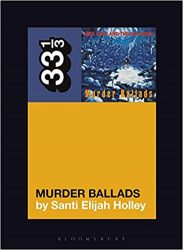
 I’ve been lucky enough to get hold of an e-book or two from regular reviewer Rick Bayles and, on first reading, I’d echo his thoughts that the Bloomsbury 331/3 series is excellent – even bearing in mind Frank Zappa’s warning that ‘Writing about music is like dancing about architecture’. Well, he wasn’t always right and he isn’t in this case. Holley is a journalist and essayist based in Portland, Oregon, writing about music, books, culture, and religion. In this, his first published book, he considers Nick Cave’s album, ‘Murder Ballads’, allied to a wider examination of the genre.
I’ve been lucky enough to get hold of an e-book or two from regular reviewer Rick Bayles and, on first reading, I’d echo his thoughts that the Bloomsbury 331/3 series is excellent – even bearing in mind Frank Zappa’s warning that ‘Writing about music is like dancing about architecture’. Well, he wasn’t always right and he isn’t in this case. Holley is a journalist and essayist based in Portland, Oregon, writing about music, books, culture, and religion. In this, his first published book, he considers Nick Cave’s album, ‘Murder Ballads’, allied to a wider examination of the genre.
What are Murder Ballads and where do they come from? Only two songs on the album are credited as essentially traditional, ‘Stagger Lee’, and, ‘Henry Lee’. Holley explores the likely and possible backgrounds to the seven tracks penned by Cave, either singly or in collaboration with others. The final number, ‘Death is Not the End’, is by Bob Dylan but Holley is also able to trace the roots of this composition dating from Dylan’s ‘born again’ period. The roots of many of these songs reside in the mists of time and the folk history of America, England and Scotland.
‘They were joining a long tradition of songwriting and song interpretation, a tradition spanning many thousands of years, several continents, and many piles of bodies’.
This book is not a biography but it is according to Holley,
‘An examination of the themes and background of each of the ten songs on, ‘Murder Ballads’, drawing on critical analysis, history, interviews and research’
Ballads are defined variously; for instance as, ‘Short narrative poems’, often without an author or at least not one readily discernible. Copyright and historical and factual accuracy are not necessarily seen as an issue and they are not usually about multiple murder, often seen as crimes of passion. They also tend to be serious – there is little levity in these sad tales
Holley calls out the essentially misogynistic, male-dominated, female objectifying, entertainment industry. Christina Ruth Hastie, to whom Holley refers, in her essay, ‘This Murder Done’; Misogyny Femicide and Modernity in 19th Century Appalachian Murder Ballads’, makes it clear that what is being considered is often deep misogyny, generally the murder of women, often beautiful and attractive women, by men. Holley explores this idea in some detail and it lies close to the heart of his analysis. Dressed up as it may be in florid and arcane language in some of the songs, femicide remains the dominant motivation of the homicidal men depicted here. A further key aspect is the element of overwhelming compulsion reported by such men (and men they usually are). Holley also reflects on Cave’s sometimes ambivalent fascination with the genre – enjoyment and revulsion side by side, but nonetheless a theme that has been present in his songs over many years.
So not a whole lot directly about music so far, much more about culture, history and their interpretation; but then that is not the authors aim and if that is all you are looking for then reading this book would not be your first choice. However, there is plenty of interest for those who read on.
The book is laid out with chapters related directly to each track. The first considers the opener, ‘Song of Joy’, a Cave original about a mysterious traveller at the door of an unnamed stranger. The track was apparently written as a kind of catharsis following a less than happy tour of America. Once written it was felt that the need was for an album of similar material to give it a suitable home. Holley examines the potentially unreliable narrator who may or may not have murdered his entire family. Links are woven between Milton, Jekyll and Hyde, Byron, Adam and Eve, the Ballad of Hollis Brown, the depression era murder of the entire Lawson family, the ‘calling cards’ of serial killers and the ‘red right hand of God’. Impressively diverse and wide-ranging connections! The song’s conclusion is left nicely in the balance – will the stranger be invited in and what are his intentions if he is?
The opening chapter and its many interesting literary allusions are perhaps less directly engaging than those that follow. Most, however, will have heard the name, ‘Staggerlee’, or one of its many variants.
The story of Stagger Lee / Stack o Lee is based on that of a ‘Bad black man’, called Lee Shelton who killed William Lyons in a bar-room during an argument over a hat. The fact that he was a black man is seen as highly significant and Holley expands on how the story became a part of the identity and folklore of many men of that race over the years – a kind of prototypical ‘badass’, someone determined to take no shit – from anyone. Holley weaves an engaging and complex story around an incident that was subsequently greatly mythologised. If you like historical trivia then you will learn that Bobby Seale called his son Stagolee and you will understand where rap group the Geto Boys fits into the story.
Subsequent chapters are in a similar vein. ‘Where the Wild Roses Grow’, is a song with roots in Ireland about one Rose Connolly and the song, ‘Down in the Willow Garden’. It was written by Cave for, and performed with, Kylie Minogue and was his biggest international hit. It seems appropriate that one as apparently fresh and innocent as Minogue should duet on a track about the wilful and pointless destruction of innocence and beauty. As the killer says as he murders his victim, ‘All beauty must die’.
Each of the remaining chapters examines a song in similar fashion and whilst initially I questioned how wide the net was thrown, you are likely to be drawn in as to just how Cecil Sharp and Mary Bell, Tennessee Williams and Brett Easton Ellis’s American Psycho become part of the narrative.
There is considerable emotional heft to much of Cave’s work and it seems that he is both a cerebral man and artist. Therefore, it is likely that fans of his music may well have a similar disposition – not that this is a hard book to read and don’t be put off by, ‘Bloomsbury Academic‘. If that is a fair guess then this is the book for those who see popular music as an art form worthy of proper study and consideration; being a fan of Cave is a bonus but not essential. If you want to read or hear about incandescent guitar solos, inter-band rivalries and on tour hi-jinks then better to look elsewhere (not that we’re not partial to a bit of rock and roll gossip). It’s clear that the ballad form has considerable roots and history and thus plenty to ponder, consider and discuss, without the need for metaphorical or literal investigation of rubbish bins for source material.
An interesting, well written (2 – 3 hours should be plenty) and recommended read.



Thanks for the interesting review. A must have!
Hi Fiona – I do recommend it both as something about Nick Cave – and to be honest I am not a big fan – but also as a wider treatise on the subject of murder ballads. Happy reading – if thats the right phrase ?